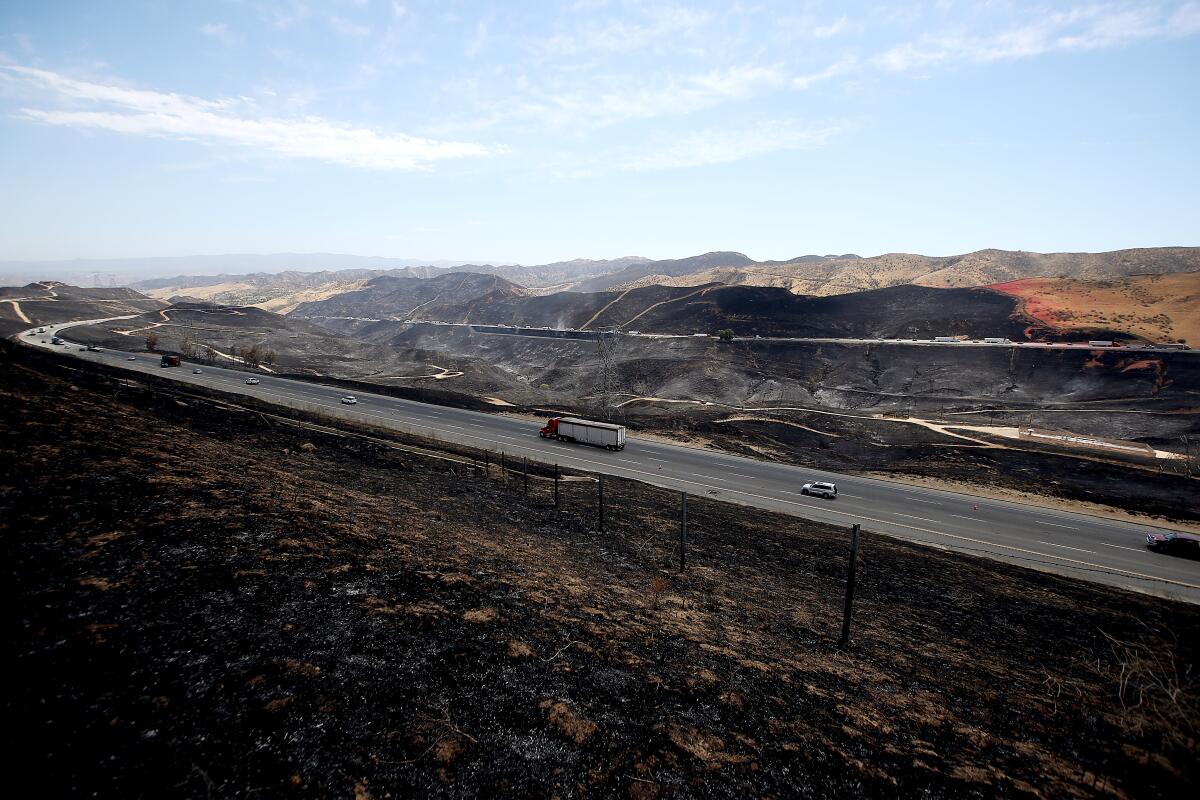Newsletter: Pakistan’s floods. China’s summer. Our heat wave. What more do climate deniers need?

- Share via
Good morning. I’m Paul Thornton, and it is Saturday, Sept. 3. It’s really hot in California, so here is some advice for staying safe (if not cool) during the extended heat wave. Now, let’s look back at the week in Opinion.
I opened last week’s newsletter by noting the theretofore mild summer in Southern California. The point was to compare our situation with the months-long heat and drought afflicting much of China and segue into a discussion on climate change and our tendency to ignore mass suffering in far-off parts of the world, even if it previews what’s ahead for us. The rhetorical contrast served its purpose, but rest assured that’s the last time for a while I’ll tempt the weather fates.
Disturbingly, the response from a handful of readers reminded me of the persistence of old-fashioned climate denialism — the early 2000s kind, where the basic physical properties of greenhouses gases are ignored, and the whole warming trend is a fiction cooked up by elites. Today, denialism tends to take the form of “nuanced” defeatism that is a smokescreen for continued fossil fuel dominance.
Upsetting as this was, it was a helpful reminder that the proponents of decisive climate action need to show the on-the-ground realities revealing the truth of climate change — say, the effects already being felt by our children, among other examples. Thankfully, some of our recent and further back Opinion coverage can help.
First, allow me to get personal: As the heat wave was getting underway this week and I was dropping my children off at school, I fixated on the unshaded, black asphalt expanse designated a “playground.” On sunny days, the surface radiates heat, even with cooler air temperatures — so when the forecast high is 104 degrees, the playground becomes a hazard. Last March, editorial writer Tony Barboza called the prevalence of these hardtop hellscapes an “environmental injustice” for L.A.’s public school students and cited the urgent need to swap them out for greener, shaded, cooler play spaces. The reason, of course, was climate change and the need to adjust not only to a future of longer and hotter heatwaves, but also to the current, warmer reality.
Then there’s the matter of keeping the electricity running (and our air conditioners humming) during heat waves, and without starting another massive wildfire from old and poorly maintained power lines. The offender that immediately comes to mind is the state’s largest utility, Pacific Gas & Electric, which operated the wind-whipped transmission line that failed and sparked the 2018 Camp fire, killing 84 people in and around the Sierra Nevada foothill town of Paradise. In an op-ed piece this week, energy reporter Katherine Blunt discusses whether transferring ownership of PG&E to the public would reduce wildfire risk and make electricity service safer and more reliable. Her analysis is unsettling, and I highly encourage anyone concerned about fire safety where high-voltage transmission lines run to read her whole piece.
Finally, consider California’s new mandate to eliminate the sale of new gas-powered cars by 2035. Today, slick marketing campaigns would have us believe one can walk into most dealerships and pick from an abundance of clean cars, but as a driver of an electric vehicle, I can tell you it isn’t that easy. The new state regulation should fix that, and sooner than 2035, as zero-emission vehicles will have to make up 35% of new car sales by 2026 and steadily account for a greater proportion every year until hitting 100% in 2035. Problem is, as journalist Edward Humes notes in an op-ed article, California passed an EV sales mandate 32 years ago but killed it in 2003 under pressure from SUV-hawking automakers. Humes cautions regulators to steel themselves for further delay tactics as deadlines for phasing out gas-guzzler sales approach.
Note that the policy prescriptions for cooler school playgrounds, safer utilities and greater EV sales come not amid an ideological crusade or predictions of catastrophe but in response to catastrophes that have already happened or are unfolding now. In 2020, more than 4% of California’s total land area burned, setting a record for the state’s worst wildfire year. We didn’t fare much better in 2021, the second-worst wildfire year. The time for avoiding a climate emergency has passed; now’s the time for policies that encourage adaptation and end our use of fossil fuels to prevent unimaginable upheaval — certainly worse than this heat wave and more devastating that China’s summer-long sweltering or Pakistan’s cataclysmic monsoon floods.
Remember when we thought George W. Bush was the worst president ever? Columnist Nicholas Goldberg says Donald Trump changed everything, even our perception of the 43rd president: “Yes, it was Bush not Trump who signed the Patriot Act into law and mishandled Hurricane Katrina and presided over the start of Great Recession and championed the privatization of Social Security. He was the doofus who extolled Americans who were ‘working hard to put food on your family’ and asked ‘Is your children learning?’ and then dared to insist he’d been ‘misunderestimated.’ His policies led to a lot more deaths than Trump’s did. But at the end of the day, there’s a meaningful distinction in my mind between the wrongs perpetrated by Bush and those attributable to Trump, who for my money really was the worst president, certainly of my lifetime.” L.A. Times
Opposing columnist views on student loan relief: Jonah Goldberg says a giveaway to college graduates with high earning potential is anything but progressive. LZ Granderson says he sees the student debt crisis as “very much like a FEMA moment, and I’m thankful government is stepping up to help.” Readers are just as torn over President Biden forgiving $10,000 in student debt for most borrowers and $20,000 for Pell Grant recipients.
What’s wrong with the Atlantic’s “Newsom is the DeSantis of the left” piece? Just about everything. The topline problem, of course, is holding up Gov. Gavin Newsom’s stupid political trolling for comparison to a Republican governor who intimidates lawful voters, unilaterally suspends political opponents, makes school book bans easier, enacts a “don’t say gay” law and bans all abortions after 15 weeks of pregnancy. DeSantis is an authoritarian emulated by other Republican governors; Newsom is a competent, mainstream Democratic governor who sometimes sticks his foot in his mouth or talks out of both sides of it. I’m having a hard time believing this commentary was written by the same journalist who deftly identified the blue-city hypocrisy feeding California’s housing crisis, because he abandons that nuance by faulting Newsom for a number of ills (the housing shortage included), when his administration is actually targeting NIMBY cities like San Francisco for perpetuating them. I could go on about the writer’s willfully facile analysis of the state’s deeply rooted dysfunction, so I’ll leave it at this: If you want a good example of a piece that bashes California for the cheap pleasure of a non-California audience, click the link that follows this sentence. The Atlantic
Enjoying this newsletter? Consider subscribing to the Los Angeles Times
Your support helps us deliver the news that matters most. Become a subscriber.
A big GOP “uh-oh”: Republican midterm candidates try to hide their antiabortion truths. Columnist Robin Abcarian assesses the current political moment: “Not long ago, it was a foregone conclusion that Republicans would take back the House in November and probably the Senate, too. It was simply presumed that the worst inflation in 40 years, fears about crime and immigration, plus Biden’s low, nearly Trumpian, approval ratings would destroy Democrats’ chances in Congress. My guess is it won’t be the widespread approval of Biden’s palpable legislative successes — on climate change, healthcare and student debt — that will bring Democrats success in November. It will be rage over Republican efforts to turn women into second-class citizens again.” L.A. Times
Who pays the bill for sheriff misconduct? You do. The $30 million awarded to Vanessa Bryant and another plaintiff in their lawsuit against L.A. County over sheriff’s deputies and firefighters who took and shared photos of the Kobe Bryant helicopter crash scene won’t be covered by the wrongdoers. The Times Editorial Board says it may be time for some reform: “What if the sheriff were evaluated and compensated, in part based on liabilities incurred by deputies? That’s not a short-term solution to misconduct. But in the longer term, as voters, taxpayers and activists look for ways to repair the broken links in the law enforcement accountability chain, it might make sense to tie a sheriff’s or police chief’s job security and compensation to his or her ability to correct the costly wrongdoing of rank-and-file deputies and officers.” L.A. Times
Stay in touch.
If you’ve made it this far, you’re the kind of reader who’d benefit from subscribing to our other newsletters and to The Times.
As always, you can share your feedback by emailing me at [email protected].
A cure for the common opinion
Get thought-provoking perspectives with our weekly newsletter.
You may occasionally receive promotional content from the Los Angeles Times.




